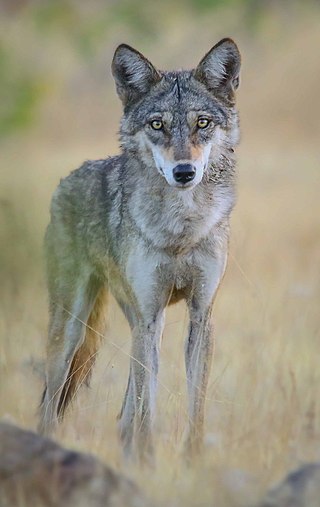
The coyote is a species of canine native to North America. It is smaller than its close relative, the wolf, and slightly smaller than the closely related eastern wolf and red wolf. It fills much of the same ecological niche as the golden jackal does in Eurasia. The coyote is larger and more predatory and was once referred to as the American jackal by a behavioral ecologist. Other historical names for the species include the prairie wolf and the brush wolf.

The wolf, also known as the gray wolf or grey wolf, is a large canine native to Eurasia and North America. More than thirty subspecies of Canis lupus have been recognized, including the dog, though gray wolves, as popularly understood, only comprise wild subspecies. The wolf is the largest extant member of the family Canidae, and is further distinguished from other Canis species by its less pointed ears and muzzle, as well as a shorter torso and a longer tail. The wolf is nonetheless related closely enough to smaller Canis species, such as the coyote and the golden jackal, to produce fertile hybrids with them. The wolf's fur is usually mottled white, brown, gray, and black, although subspecies in the arctic region may be nearly all white.

Shere Khan is a fictional Bengal tiger and the main antagonist of Rudyard Kipling's Jungle Book and its adaptations. The name roughly translates as tiger ruler, with shere being the Persian word for 'tiger' and khan being used as a title of distinction among the Turco-Mongol peoples, usually meaning chief or ruler. According to The Kipling Society, the name "show[s] that he is the chief among tigers."

White Fang is a novel by American author Jack London (1876–1916) — and the name of the book's eponymous character, a wild wolfdog. First serialized in Outing magazine between May and October 1906, it was published in book form in October 1906. The story details White Fang's journey to domestication in Yukon Territory and the Northwest Territories during the 1890s Klondike Gold Rush. It is a companion novel to London's best-known work, The Call of the Wild (1903), which is about a kidnapped, domesticated dog embracing his wild ancestry to survive and thrive in the wild.

The Beast of Gévaudan is the historic name associated with a man-eating animal or animals that terrorised the former province of Gévaudan, in the Margeride Mountains of south-central France between 1764 and 1767. The attacks, which covered an area spanning 90 by 80 kilometres, were said to have been committed by one or more beasts with formidable teeth and immense tails, according to contemporary eyewitnesses. Most descriptions from the period identify the beast as a striped hyena, wolf, dog, or wolf-dog hybrid.

Wolf hunting is the practice of hunting gray wolves (Canis lupus) or other species of wolves. Wolves are mainly hunted for sport, for their skins, to protect livestock and, in some rare cases, to protect humans. Wolves have been actively hunted since 8,000 to 10,000 years ago, when they first began to pose a threat to livestock of Neolithic human communities. Historically, the hunting of wolves was a huge capital- and manpower-intensive operation. The threat wolves posed to both livestock and people was considered significant enough to warrant the conscription of whole villages under threat of punishment, despite the disruption of economic activities and reduced taxes. The hunting of gray wolves, while originally actively endorsed in many countries, has become a controversial issue across the globe. Most people see it as cruel, unnecessary and based on misconceptions, while proponents argue that it is apparently vital for the conservation of game herds and as pest control.
Pardhi is a Hindu tribe in India. The tribe is found mostly in Maharashtra and parts of Madhya Pradesh however small numbers can be found in Gujarat and Andhra Pradesh. The word Pardhi is derived from the Marathi word ‘Paradh’ which means hunting and Sanskrit word ‘papardhi’ which means hunting or the game to be hunted. In some parts of India Pardhis are known as Meywarees. They also have various other names like Advichincher, Phans Pardhi, Phanse Pardhi, Langoli Pardhi, Bahelia, Bahellia, Chita Pardhi, Shikari, Takankar, Takia Pardhi. Pardhi tribe is divided in groups like Vaghri Pardhi and Phase Pardhi. These are further divided into subgroups like Pal Pardhi, Gav Pardhi, Takankar, Takari. Widely found surnames among them include Chauhan (Chavan), Rathod and Solanke.

The Eurasian wolf, also known as the common wolf, is a subspecies of grey wolf native to Europe and Asia. It was once widespread throughout Eurasia prior to the Middle Ages. Aside from an extensive paleontological record, Indo-European languages typically have several words for "wolf", thus attesting to the animal's abundance and cultural significance. It was held in high regard in Baltic, Celtic, Slavic, Turkic, ancient Greek, Roman, and Thracian cultures, whilst having an ambivalent reputation in early Germanic cultures.

The Indian wolf is a subspecies of gray wolf that ranges from Southwest Asia to the Indian Subcontinent. It is intermediate in size between the Himalayan wolf and the Arabian wolf, and lacks the former's luxuriant winter coat due to it living in warmer conditions. Within this subspecies, the "Indian plains wolf" is genetically basal to all other extant Canis lupus apart from the older-lineage Himalayan wolf, with both proposed as separate species. The Indian wolf travels in smaller packs and is less vocal than other variants of the gray wolf, and has a reputation for being cunning. The Indian wolf is one of the most endangered populations of gray wolf in the world.

Wolf attacks are injuries to humans or their property by any subspecies of wolf. Their frequency varies with geographical location and historical period, but overall gray wolf attacks are rare. Wolves today tend to live mostly far from people or have developed the tendency and ability to avoid them. The country with the most extensive historical records is France, where nearly 7,600 fatal attacks were documented from 1200 to 1920. There are few historical records or modern cases of wolf attacks in North America. In the half-century up to 2002, there were eight fatal attacks in Europe and Russia, three in North America, and more than 200 in south Asia. Experts categorize wolf attacks into various types, including rabies-infected, predatory, agonistic, and defensive.

The Jungle Book: Mowgli's Story is a 1998 American adventure film directed by Nick Marck, produced by Mark H. Orvitz and written by José Rivera and Jim Herzfeld. It is the third film adaptation by The Walt Disney Company of the Mowgli stories from The Jungle Book (1894) by Rudyard Kipling. It stars Brandon Baker, and features the voice work of Brian Doyle-Murray, Eartha Kitt, Clancy Brown, Peri Gilpin, and Sherman Howard.
A man-eater is an animal that preys on humans as a pattern of hunting behavior. This does not include the scavenging of corpses, a single attack born of opportunity or desperate hunger, or the incidental eating of a human that the animal has killed in self-defense. However, all three cases may habituate an animal to eating human flesh or to attacking humans, and may foster the development of man-eating behavior.

Tiger attacks are an extreme form of human–wildlife conflict which occur for various reasons and have claimed more human lives than attacks by any of the other big cats. The most comprehensive study of deaths due to tiger attacks estimates that at least 373,000 people died due to tiger attacks between 1800 and 2009 averaging about 1800 kills per year, the majority of these attacks occurring in India, Nepal and Southeast Asia.

The Sight is a young adult fantasy novel written by British author David Clement-Davies. It is the first novel in The Sight series, with its sequel Fell taking place after. It follows a pack of wolves cursed by a lone wolf, Morgra, whose powers foretell the destiny of one of the mother wolf's pups: Larka, a white wolf gifted with a mysterious power known as The Sight. The story follows Larka's life as she is burdened with pain and terror that comes with the prophecy, as well as seeing the viewpoints of Larka's parents, Huttser and Palla, and her adoptive brother Kar.
The Tigers of Chowgarh were a pair of man-eating Bengal tigers, consisting of an old tigress and her sub-adult cub, which for over a five-year period killed a reported 64 people in eastern Kumaon over an area spanning 1,500 square miles (3,900 km2). The tigress was attacking humans initially alone, but later she was assisted by her sub-adult cub. The figures however are uncertain, as the natives of the areas the tigers frequented claimed double that number, and they do not take into account victims who survived direct attacks but died subsequently. Both tigers were killed by Jim Corbett.
The Wolf of Gysinge was a man-eating wolf which, in three months, attacked and killed many children in Gysinge near central Sweden in the early 1820s.

A feral child is a young individual who has lived isolated from human contact from a very young age, with little or no experience of human care, social behavior, or language. The term is used to refer to children who have suffered severe abuse or trauma before being abandoned or running away. They are sometimes the subjects of folklore and legends, typically portrayed as having been raised by animals. While there are many cases of children being found in proximity to wild animals, there is no credible evidence for animals feeding or caring for children. The behaviors described as being "like an animal" have been found to be the result of misdiagnosed conditions such as autism, deafness, or intellectual disability. Some persistent conditions are the result of the children missing the critical period for neurological development.

Wolf: The Journey Home, originally titled Hungry for Home: A Wolf Odyssey, is a 1997 American young adult novel written by 'Asta Bowen. Originally published by Simon & Schuster with line drawings by Jane Hart Meyer, it was retitled and reprinted without illustrations in 2006 by Bloomsbury Publishing. Based on true accounts of the Pleasant Valley, Montana, wolf pack, the novel traces the life of a female alpha wolf named Marta after the forced relocation of her pack in 1989 to an unfamiliar territory. Terrified, Marta abandons her pack and begins a journey in search of her home; she eventually arrives in Ninemile Valley, where she finds a new mate with whom she starts a new pack.

The 2017 Alwar mob lynching was the attack and murder of Pehlu Khan, a dairy farmer from Nuh district of Haryana, allegedly by a group of 200 cow vigilantes affiliated with right-wing Hindutva groups in Behror in Alwar, Rajasthan, India on 1 April, 2017. Six others who were with Pehlu Khan were also beaten by the cow vigilantes.














